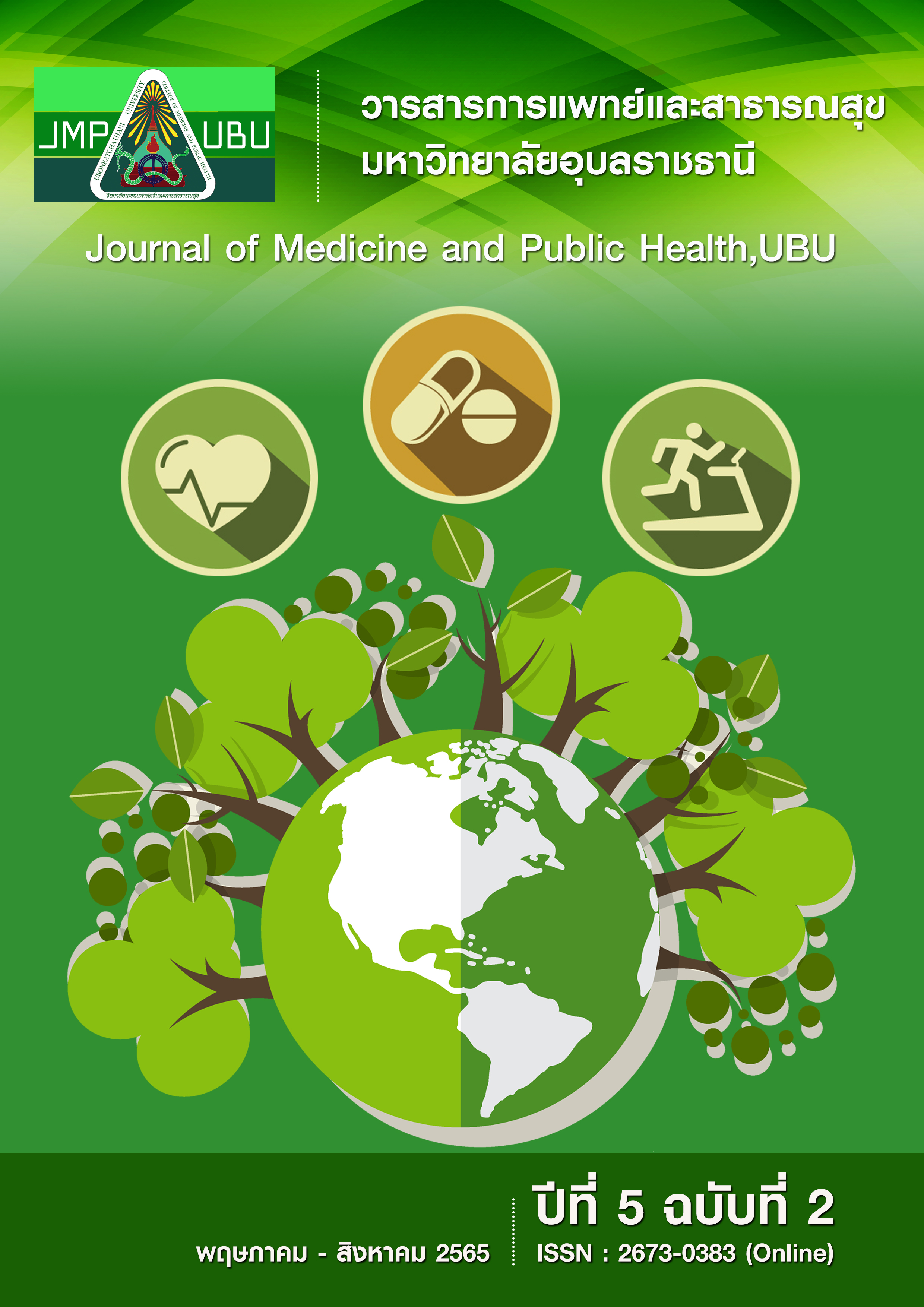Depression risk screening among students at Ubon Ratchathani University
Keywords:
Depression, Screening, StudentAbstract
Depressive disorder is one of the most common psychiatric disorders that can affect all populations and significantly impact one’s academics, occupation, and daily life. Depression is a major clinical symptom of depressive disorders. This study was a cross-sectional descriptive study aimed to study depression-related prevalence and risk factors among the students at Ubon Ratchathani University. Data were collected from undergraduate students in the academic year 2017. Research tools included a demographic characteristic questionnaire, a depression screening of 15 questions by the Department of Mental Health. For descriptive statistics, frequencies, percentages, means, and standard deviations were used, whereas chi-square and logistic regression were used as inferential statistics. Out of the total 1,890 enrolled students, 71.43 % were female. Using the cut-off score (non-depressive ≤ 6, depressive > 6), there were 704 students who had scores higher than 6 (37.0%). The risk factor of depression includes the age group of 18-20 years old, students who study in the faculty of humanities and social sciences, participants who do not specify monthly incomes or report their medical problems, those with school difficulties, family issues, love, health, friends, personality, and others problem. Those listed are at higher risk of developing depression. There are many factors that can contribute to risk of depression. Activities to reduce risk factors should be initiated.
Downloads
References
Malhi GS, Mann JJ. Depression. Lancet. 2018;392(10161):2299-312.
Flint J, Kendler KS. The genetics of major depression. Neuron. 2014;81(3):484-503.
Hasin DS, Sarvet AL, Meyers JL, Saha TD, Ruan WJ, Stohl M, et al. Epidemiology of Adult DSM-5 Major Depressive Disorder and Its Specifiers in the United States. JAMA Psychiatry. 2018;75(4):336-46.
Hammer-Helmich L, Haro JM, Jönsson B, Tanguy Melac A, Di Nicola S, Chollet J, et al. Functional impairment in patients with major depressive disorder: the 2-year PERFORM study. Neuropsychiatr Dis Treat. 2018;14:239-49.
คณะทำงานจัดทำแนวทางการจัดการโรคซึมเศร้าสำหรับแพทย์เวชปฏิบัติทั่วไปในสถานบริการระดับปฐมภูมิและทุติยภูมิ. แนวทางการจัดการโรคซึมเศร้าสำหรับแพทย์เวชปฏิบัติทั่วไปในสถานบริการระดับปฐมภูมิและทุติยภูมิ = Clinical practiceguideline of major depressive disorder for general practitioner : CPG-MDD-GP. นนทบุรี: กรมสุขภาพจิต; 2553.
นันทิรา หงส์ศรีสุวรรณ์. ภาวะซึมเศร้า. วารสารมหาวิทยาลัยหัวเฉียวเฉลิมพระเกียรติวิชาการ. 2559;19(38):105-18.
พัชราวรรณ แก้วกันทะ, สมพร รุ่งเรืองกลกิจ. ความชุกของภาวะซึมเศร้าในนักศึกษาระดับอุดมศึกษาแห่งหนึ่งในจังหวัดเชียงราย. พยาบาลสาร. 2558;42(4):48-64.
อารีรัตน์ ศิริพงษ์พันธ์ . ความชุกของภาวะซึมเศร้าและภาวะเครียดในนักศึกษาชั้นปีที่ 1 มหาวิทยาลัยเทคโนโลยีสุรนารี. มหาวิทยาลัยเทคโนโลยีสุรนารี; 2561.
พัชรี พรรณพานิช, เมรีรัตน์ มั่นวงศ์, แพรววรินทร์ ว่องสุภัคพันธุ์, ลติพร อุดมสุข. ภาวะซึมเศร้าในนักศึกษาแพทย์ชั้นปีที่ 1-3 วิทยาลัยแพทยศาสตร์และการสาธารณสุข มหาวิทยาลัยอุบลราชธานี. ศรีนครินทร์เวชสาร. 2564;36(3):287-94.
Liu Y, Zhang N, Bao G, Huang Y, Ji B, Wu Y, et al. Predictors of depressive symptoms in college students: A systematic review and meta-analysis of cohort studies. J Affect Disord. 2019;244:196-208.
กองบริการการศึกษา มหาวิทยาลัยอุบลราชธานี . สถิตินักศึกษาปัจจุบันจำแนกตามคณะ [อินเตอร์เน็ต]. [สืบค้นเมื่อ 25 มีนาคม 2565]. แหล่งข้อมูล: https://www.ubu.ac.th/web/academic/content/ข้อมูลสถิติทางการศึกษา/.
ฐาปกรณ์ เรือนใจ, ณัฐวรินทร์ กฤติยาภิชาตกุล, พิลาสินี วงษ์นุช, วิวัฒน์ แก้วดวงเล็ก. ความชุกและปัจจัยเสี่ยงที่มีความสัมพันธ์กับภาวะซึมเศร้าของนักศึกษาสาธารณสุขสาสตร์ ส านักวิชาวิทยาศาสตร์สุขภาพ มหาวิทยาลัยแม่ฟ้าหลวง. ลำปางเวชสาร. 2559;37(1):9-15.
ทวี ตั้งเสรี, กนกวรรณ กิตติวัฒนากูล, ทัศนีย์ กุลจนะพงศ์พันธ์, วัชนี หัตถพนม, วราภรณ์ รัตนวิศิษฐ์,ไพลิน ปรัชญคุปต์. การศึกษาความถูกด้องของแบบคัดกรองภาวะซึมเศร้า. ขอนแก่น: โรงพิมพ์พระธรรมขันต์; 2546.
อธิชาติ โรจนะหัสดิน, จันทิมา อังคพณิชกิจ. สถานการณ์ภาวะซึมเศร้าของนักศึกษามหาวิทยาลัยไทย. วารสารเทคโนโลยีสุรนารี 2564;15(1):61-86.
สายฝน สีนอเพีย, รุจิรา ดวงสงค์. ปัจจัยที่มีความสัมพันธ์กับความเครียดและภาวะซึมเศร้าในนักศึกษาระดับปริญญาตรี ชั้นปีที่ 1 มหาวิทยาลัยขอนแก่น. วารสารวิจัยสาธารณสุขศาสตร์ มหาวิทยาลัยขอนแก่น. 2564;14(3):10-23.
Samaranayake CB, Fernando AT. Satisfaction with life and depression among medical students in Auckland, New Zealand. N Z Med J. 2011;124(1341):12-7.
Katon WJ. Epidemiology and treatment of depression in patients with chronic medical illness. Dialogues in clinical neuroscience. 2011;13(1):7-23.
กรรณิการ์ กาญจนสุวรรณ, ชนัญญา จิระพรกุล, เนาวรัตน์ มณีนิล. ภาวะซึมเศร้าในนักศึกษาสาขาทางวิทยาศาสตร์สุขภาพสาขาหนึ่งของประเทศไทย. วารสารสมาคมจิตแพทย์แห่งประเทศไทย 2563;65(4):343-54.
Downloads
Published
How to Cite
Issue
Section
License
Copyright (c) 2022 วารสารการแพทย์และสาธารณสุข มหาวิทยาลัยอุบลราชธานี

This work is licensed under a Creative Commons Attribution-NonCommercial-NoDerivatives 4.0 International License.
เนื้อหาและข้อมูลในบทความที่ลงตีพิมพ์ในวารสารการแพทย์และสาธารณสุข มหาวิทยาลัยอุบลราชธานี ถือเป็นข้อคิดเห็นและความรับผิดชอบของผู้เขียนบทความโดยตรง ซึ่งกองบรรณาธิการวารสารไม่จำเป็นต้องเห็นด้วย หรือร่วมรับผิดชอบใด ๆ
บทความ ข้อมูล เนื้อหา รูปภาพ ฯลฯ ที่ได้รับการตีพิมพ์ในวารสารการแพทย์และสาธารณสุข มหาวิทยาลัยอุบลราชธานี ถือเป็นลิขสิทธิ์ของวารสารการแพทย์และสาธารณสุข มหาวิทยาลัยอุบลราชธานี กองบรรณาธิการไม่สงวนสิทธิ์ในการคัดลอกเพื่อการพัฒนางานด้านวิชาการ แต่ต้องได้รับการอ้างอิงที่ถูกต้องเหมาะสม






